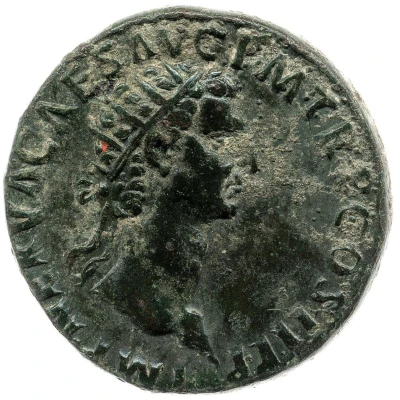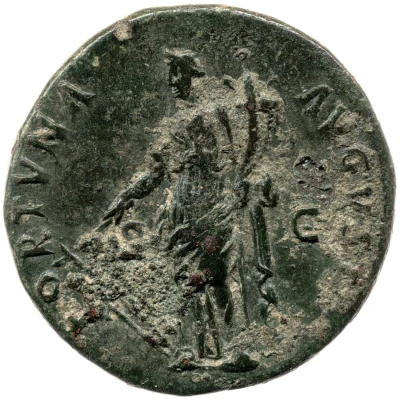


© Trustees of the British Museum
Dupondius - Nerva FORTVNA AVGVST S C; Fortuna
96 year| Bronze | 12.2 g | 28.5 mm |
| Issuer | Rome › Roman Empire (27 BC - 395 AD) |
|---|---|
| Emperor | Nerva (Marcus Cocceius Nerva) (96-98) |
| Type | Standard circulation coin |
| Year | 96 |
| Value | 1 Dupondius = ⅛ Denarius |
| Currency | Denarius, Reform of Augustus (27 BC – AD 215) |
| Composition | Bronze |
| Weight | 12.2 g |
| Diameter | 28.5 mm |
| Shape | Round (irregular) |
| Technique | Hammered |
| Demonetized | Yes |
| Updated | 2024-10-06 |
| Numista | N#252492 |
|---|---|
| Rarity index | 95% |
Reverse
Fortuna, draped, standing left, holding rudder set on ground in right hand and cornucopiae in left.
Script: Latin
Lettering: FORTVNA AVGVST S C
Translation:
Fortuna Augusti. Senatus Consultum.
Good fortune of the emperor. Decree of the senate.
Comment
Mass varies: 11.55–12.77 g;Source: Online Coins of the Roman Empire (OCRE)
Interesting fact
The Dupondius coin featuring Nerva (96) from the Roman Empire (27 BC - 395 AD) is interesting because it was minted during a time of significant economic and political change. The coin's design, which depicts Fortuna, the goddess of luck and prosperity, on one side and Nerva, the Roman emperor, on the other, symbolizes the Empire's shift towards a more centralized and autocratic government. Additionally, the use of bronze as the material for the coin reflects the Empire's efforts to reduce the cost of coin production and increase the circulation of currency, which had a significant impact on trade and commerce during that time.

